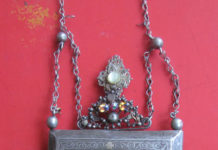Turkmens are natural born horse riders. Passion for horses is instilled from childhood. Akhal-Teke were bred by Turkmens more than 5000 years ago in the foothills of Turkmenistan. When a Turkman raised a horse, it wasn’t just a mere helper, he raised a friend. A warrior’s life depended on such horse. Turkmen horses were depicted by explorer and orientalist Armin Vambery as more important to the owner than family or even their own life.
Turkmens are very fond of horse races and approach preparations with great responsibility. This knowledge is passed from generation to generation. The horse, a faithful companion to the nomad warrior, needed reliable protection from enemy arrows and blades. This necessity of war was transformed into an element of adoration. Metal plates and armor transformed into items of jewelry. Horse trappings altogether are called at shayi, which means horse adornments and includes uyon (bridle), govyusbent (breast strap), gozlyuk (forehead adornment) and alagayish (collars). The bridle consisted of thin straps with silver plates and cornelian stones at the junction of straps.
It is worth noting that cheek belt’s length could not be regulated. It was presumed that every rider has his own personal set of equipment. Forehead adornment consisted of long fringe from leather and silk, which was supposed to provide protection for horse’s eyes from insects. It was attached to headband and also had silver plates and inserts. Alagayish consisted of two to three collars, different in width. The thin collar was worn first. Wider collars were located down the neck. Turkmens also used number of pendants and bells. Colourful lace from camel wool was used as a talisman. Sometimes this lace had an amulet bag with an excerpt from Koran.
The tradition to adorn horses remain to this day. Embroidered felt and tapestry horse cloths are widespread. Ceremonial horse trappings crafted with the use of silver, gold plating and semi-precious stones are still being made. Weight of such set can be anywhere around 3-4 kilograms. Most often craftsmen use carnelian stone. Turkmens believe that this stone protects from evil eye. Very important part of the horse harness is saddle. Turkmens say: “You might not have a horse, but you must have a saddle. If necessary, you can ask for a horse from your neighbour and surely he’ll give you the horse. But a saddle is a different case: even if he gives it to you, he won’t be too happy about it”. A nomad’s saddle was worth more than a horse. Even nowadays, a good saddle costs twice the price of a horse and can be used for 150 years. Modern craftspersons and jewelers follow ancient tradition of decorating favourite animal. Still, traditional horse trappings are an object of special care for the owner, due to the fact that horse has always played pivotal role in the life of Turkmen.





